Explore six popular generative AI-powered tools, including ChatGPT, Copilot, CodeWhisperer, Tabnine, Bing, and ChatSonic

Introduction
Modern software systems continue to grow inherently more complex over time. We have evolved from bulky monoliths to loosely coupled, event-driven, fault-tolerant, stateless, serverless, cloud-native, real-time, microservices-based, API-first, continuously deployed distributed systems, festooned with CQRS, 2PC, DDD, EDA, DOMA, Sagas, BFFs, GraphQL, gRPC, micro-frontends, contract tests, and Hexagonal architectures. Generative AI-powered coding tools do not necessarily make a developer’s job easier — they assist developers in dealing with increasing system complexity.
This post examines six popular generative AI-powered coding tools, including chat-based OpenAI ChatGPT, Microsoft’s all-new Bing Chat, and ChatSonic, as well as IDE-based Tabnine, GitHub Copilot, and Amazon CodeWhisperer (Preview). In this post, each tool will assist with developing an identical program to complete a series of common tasks on AWS. We will then compare and contrast each tool’s ease of use and the resulting code accuracy and quality.
“Generative AI coding tools are a new class of software development tools that leverage machine learning algorithms to assist developers in writing code. These tools use AI models trained on vast amounts of code to offer suggestions for completing code snippets, writing functions, and even entire blocks of code.” (quote generated by ChatGPT)
The generative AI space is evolving at a breakneck pace. Tools continue to rapidly improve their AI models, add new features, and adjust pricing. In just the short time it took to research and write this article:
- OpenAI announced GPT-4 on March 14, 2023
- Microsoft announced new Bing running on GPT-4 on March 14, 2023
- Google’s Bard AI launched in Early Access on March 21, 2023
- GPT-4 was added to Azure’s OpenAI Service on March 21, 2023
- Writesonic ChatSonic revised its pricing model on March 21, 2023
- GitHub announced GitHub Copilot X on March 22, 2023
- OpenAI announced ChatGPT plugins on March 23, 2023
Generative AI
According to McKinsey & Company in their recent article, What is generative AI?, “Generative artificial intelligence (AI) describes algorithms (such as ChatGPT) that can be used to create new content, including audio, code, images, text, simulations, and videos. Recent new breakthroughs in the field have the potential to drastically change the way we approach content creation.”
Generative AI for Code Generation
According to Papers with Code, “Code Generation is an important field to predict explicit code or program structure from multimodal data sources such as incomplete code, programs in another programming language, natural language descriptions or execution examples. Code Generation tools can assist the development of automatic programming tools to improve programming productivity.” Similarly, according to MarketTechPost, “Generative AI technologies have led to a surge of interest and progress in code generation applications. These technologies use machine learning algorithms and natural language processing to assist developers in automating the time-consuming and laborious portions of coding.”
Common Features
Standard features of leading generative AI-powered coding tools include the following:
- Whole-line, full-function, and block code completion
- Natural language to code completion
- Code suggestions based on the model’s pre-trained dataset
- Context-aware recommendations based on your existing code
- Context-aware recommendations based on your code comments
- Native integration with popular IDEs
- Multi-language coding support
- Respond to follow-up instructions (resulting in refinement of code)
Benefits
The benefits of generative AI-powered code generation include the following:
- Accelerate application development
- Improve development productivity
- Decrease development costs
- Produce higher-quality, more consistent code
- Enable better code documentation and test coverage
- Learn new programming languages and coding techniques
- Contributes to the democratization of programming
Methods of Code Generation
As you explore different generative AI tools for writing code, you will likely develop techniques for generating effective code based on the tool.
Long-form Narrative Approach
With chat-based tools like OpenAI ChatGPT, Microsoft Bing Chat, and ChatSonic, developers might use a longer narrative-type instruction (aka one-shot approach) rather than a series of more concise instructions to generate the code. For example:
- “Write a Python script to create a new DynamoDB table with a partition key of username, a sort key of last_name, and provisioned throughput of 5 RCUs and 5 WCUs. Pass the table name into the function as a variable. Wait until the table exists before continuing. Include try/except blocks and logging. If the table fails to be created, log a FATAL error and exit, and if the table already exists, log a WARNING. Add a main function and wrap everything in a Class called DynamoUtilities.”
- “Add three new functions, including a function to insert a new item into a table, a function to retrieve an item from a table, and a function to delete a table.”
Below is an example of OpenAI ChatGPT’s response using this approach. Of course, this method doesn’t limit you from following up with additional instructions to further enhance and refine the code.

Progressive Approach
Although the previous approach makes for an impressive demonstration, that method of writing code differs from how most developers work. Instead, a developer might use a progressive approach (aka chain of thought) to generate and refine the code with chat-based tools. In my tests with chat-based tools, I found a progressive approach of asking multiple, concise instructions to guide the model toward the desired behavior produced higher-quality code with fewer errors. For example:
- “Write a Python script to create a DynamoDB table with a partition key of username, a sort key of last_name, and provisioned throughput of 5 RCUs and 5 WCUs.”
- “Pass the table name into the create table function as a variable.”
- “Wait until the table exists before continuing.”
- “Add logging with the default level of INFO.”
- “Include try/except blocks, log a FATAL error and exit if the table fails to be created and a WARNING if the table already exists.”
- “Add a function to delete the table and wait until the table is deleted before continuing.”
- “Add a main function.”
- “Add a function to insert a new item into a table and a function to get an item from a table.”
- “Wrap the code in a Class called DynamoUtilities.”
- “Convert the Python code to Java.”
Below is an example of OpenAI ChatGPT’s response using a progressive code generation approach. The final code results from an initial prompt and a series of follow-up instructions to enhance and refine the code.
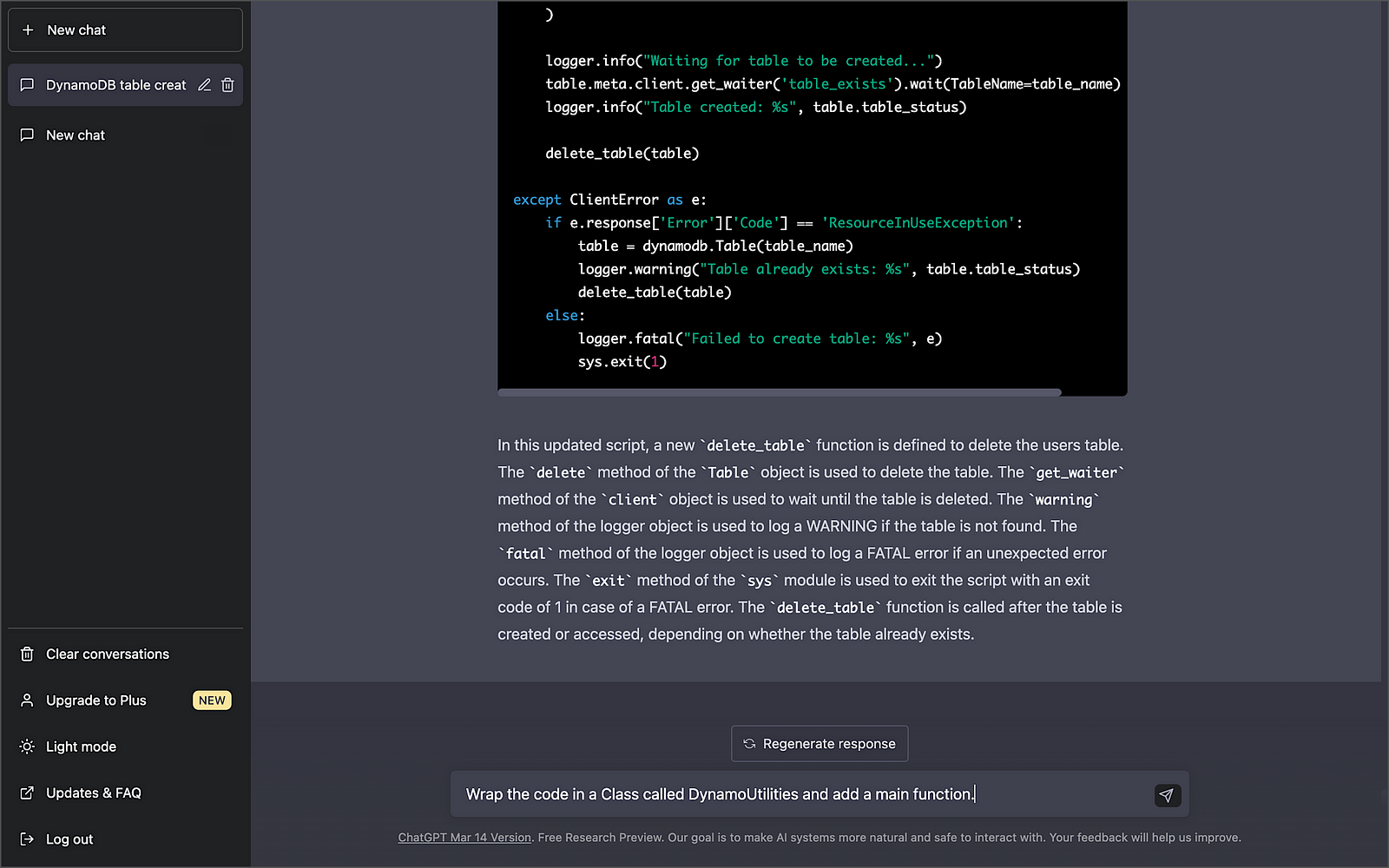
Be aware that most chat-based tools have a session limit. For example, Bing has a limit of 15 chats per session, which will limit the number of follow-up instructions you can use to modify the code. Additionally, the slightest variation in how an instruction is phrased may significantly impact the code generated. There is a whole science and blossoming industry around prompt optimization!
IDE-based Code Generation
Tabnine, GitHub Copilot, and Amazon CodeWhisperer use generative AI technology to predict and suggest new lines or blocks of code based on their trained pre-model and the context and syntax of existing code and code comments within your IDE. These tools differ from tools like OpenAI ChatGPT, Microsoft Bing Chat, and ChatSonic, which can generate code using a chat-based interaction with the user. IDE-based tools like Tabnine, GitHub Copilot, and Amazon CodeWhisperer are like having an AI-powered paired programming partner that enhances your development productivity. However, these tools also require a reasonable level of development experience, in my opinion.
Below, we see an example of Tabnine Pro’s ability to generate whole-line code completion (line 11) and full-function code completion (lines 12–41) based on the existing code context and syntax (lines 1–11).
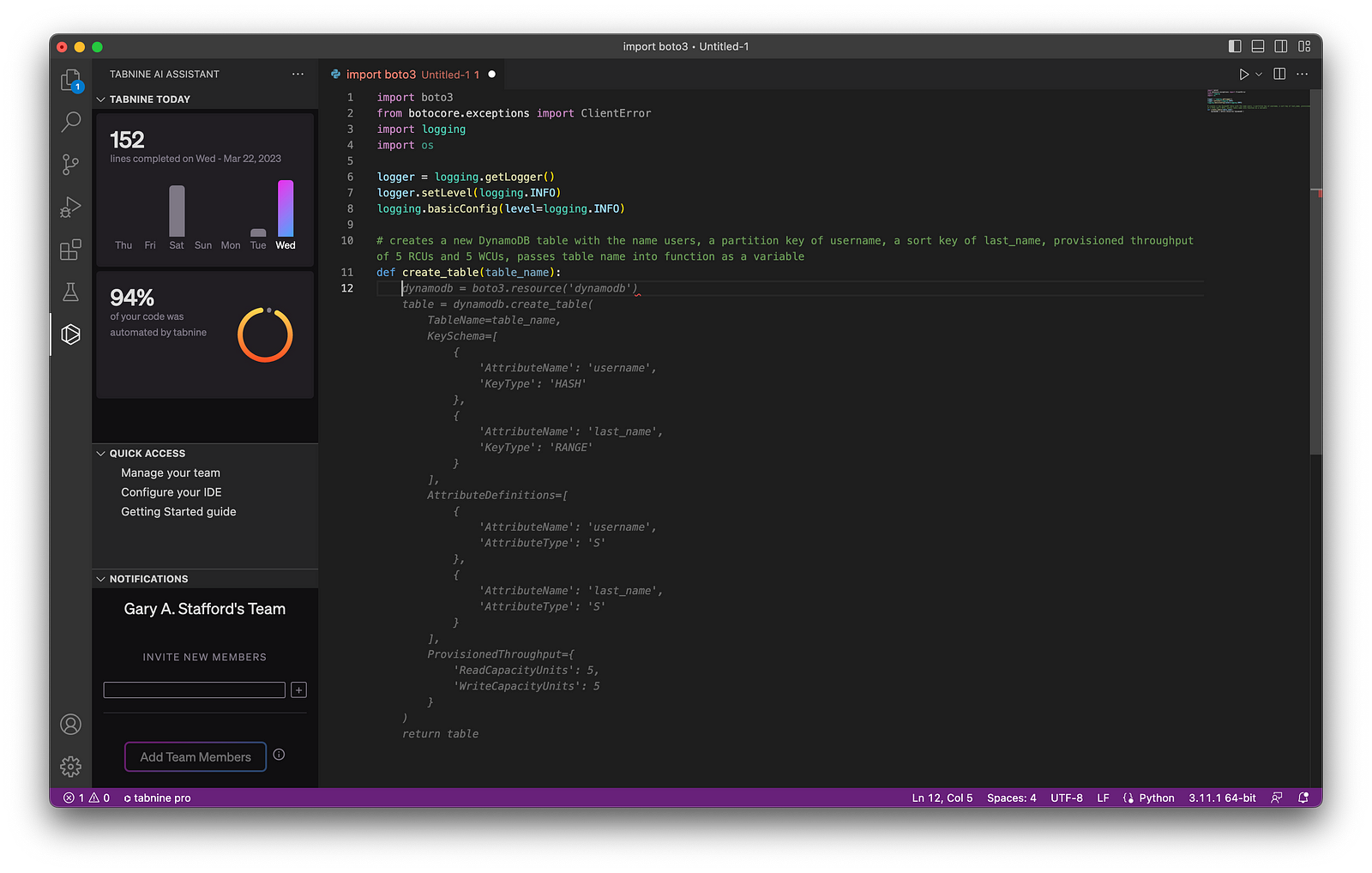
Although writing code comments may be perceived as easier than using generative code completion, many industry pundits dissuade what they call “ comment-driven development.” Instead, they believe using generative AI-based code completion results in superior results.
Testing Generative AI Tools
With the assistance of each tool, I have written a Python script to perform the following tasks: 1) create an Amazon DynamoDB table, 2) insert an item into a table, 3) retrieve an item from a table, and finally, 4) delete a table. Although I tested the results in multiple IDEs, I only included the results from Visual Studio Code (VS Code). Tool interactions and code results were consistent across IDEs.
As a reference for “what good looks like” when evaluating code accuracy and quality, I referenced the examples provided with AWS’s Boto3 SDK and DynamoDB API documentation and the PEP 8 — Style Guide for Python Code.

An example of the final code, written with the assistance of GitHub Copilot, including unit tests, is available on GitHub.
OpenAI ChatGPT

According to Wikipedia, ChatGPT (Generative Pre-trained Transformer) “is an artificial intelligence chatbot developed by OpenAI and launched in November 2022. It is built on top of OpenAI GPT-3 and GPT-4 [released March 14, 2023] families of large language models [LLMs] and has been fine-tuned (an approach to transfer learning) using both supervised and reinforcement learning techniques.”
According to the VC-backed California-based startup OpenAI, “ChatGPT interacts in a conversational way. The dialogue format makes it possible for ChatGPT to answer follow-up questions, admit its mistakes, challenge incorrect premises, and reject inappropriate requests.” Further, “ChatGPT was optimized for dialogue using Reinforcement Learning with Human Feedback (RLHF), which uses human demonstrations and preference comparisons to guide the model toward desired behavior.”
Getting Started with ChatGPT
You can get started with ChatGPT for free using the Free Plan. However, if you want to use the latest generative AI models, get faster results, and ensure availability, you should consider ChatGPT Plus for $20/month. GPT-4 is now available through the ChatGPT Plus Plan.

ChatGPT’s Free Plan is a great way to test the generative AI waters. However, due to potentially slow chat responses and unavailability during peak times, you will want to upgrade to ChatGPT Plus if your team plans to rely on the tool.

Using ChatGPT
OpenAI ChatGPT is available through a web-based chat interface or programmatically using OpenAI APIs. For API users, OpenAI provides online API references, code examples, and an interactive coding playground. According to OpenAI, “The OpenAI API can be applied to virtually any task that involves understanding or generating natural language, code, or images.”

Below is an example of output using ChatGPT’s UI. Using the UI, ChatGPT’s results are a mix of code blocks and explanatory text. ChatGPT has a straightforward, clean, and functional web-based user interface. There is a button to copy the resulting code to your clipboard, and previous chat sessions are saved and accessible.
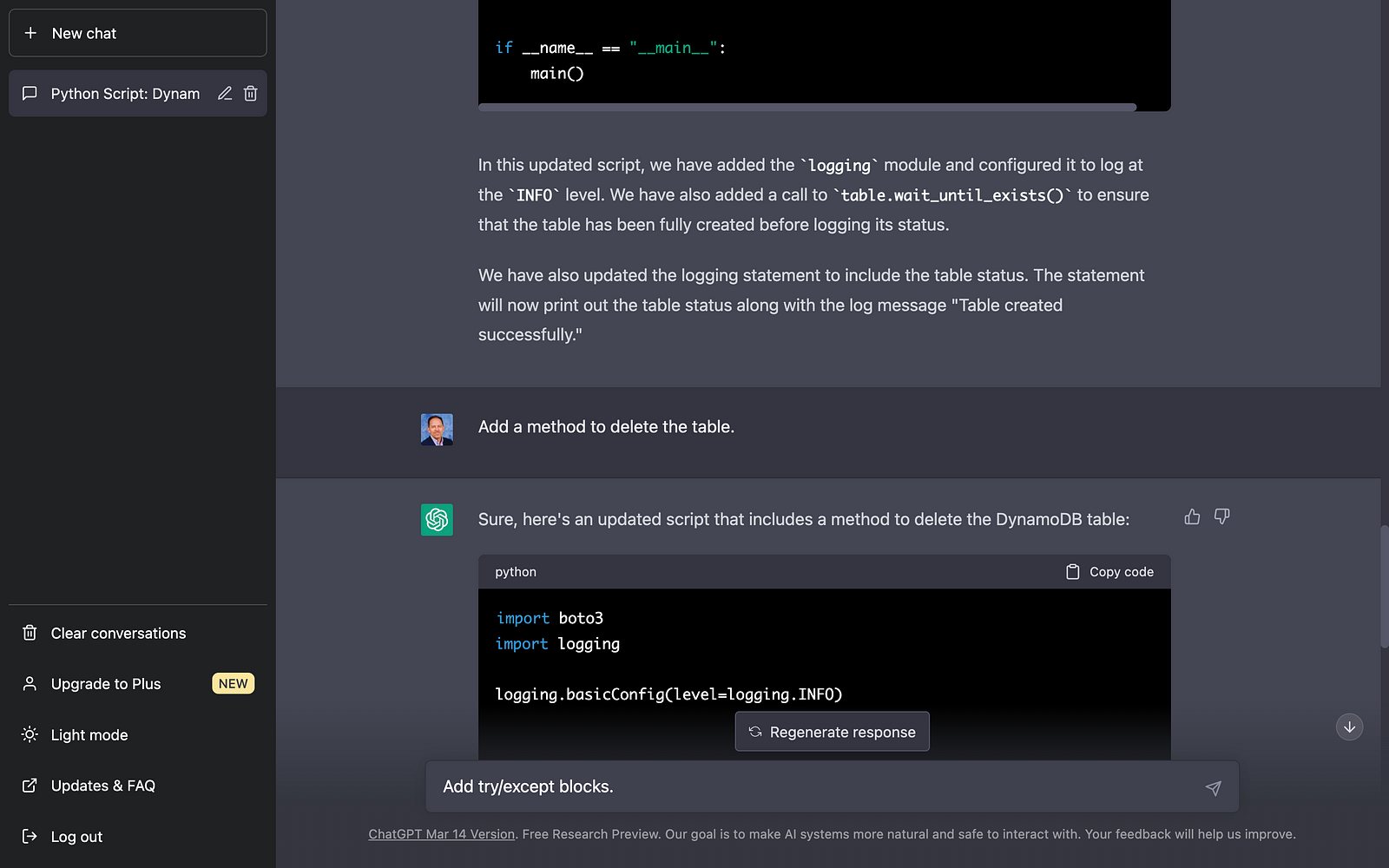
ChatGPT Results
In my tests, using a progressive chat approach to building the code with concise instructional questions versus a longer-form narrative approach produced better-quality code. The code created using a progressive chat approach was accurate, error-free, and well-written.
A significant advantage of ChatGPT is its ability to remember what happened earlier in the conversation. According to OpenAI documentation, the model can reference up to approximately 3k words (or 4k tokens) from the current conversation; any information beyond that is not stored.

Microsoft Bing Chat
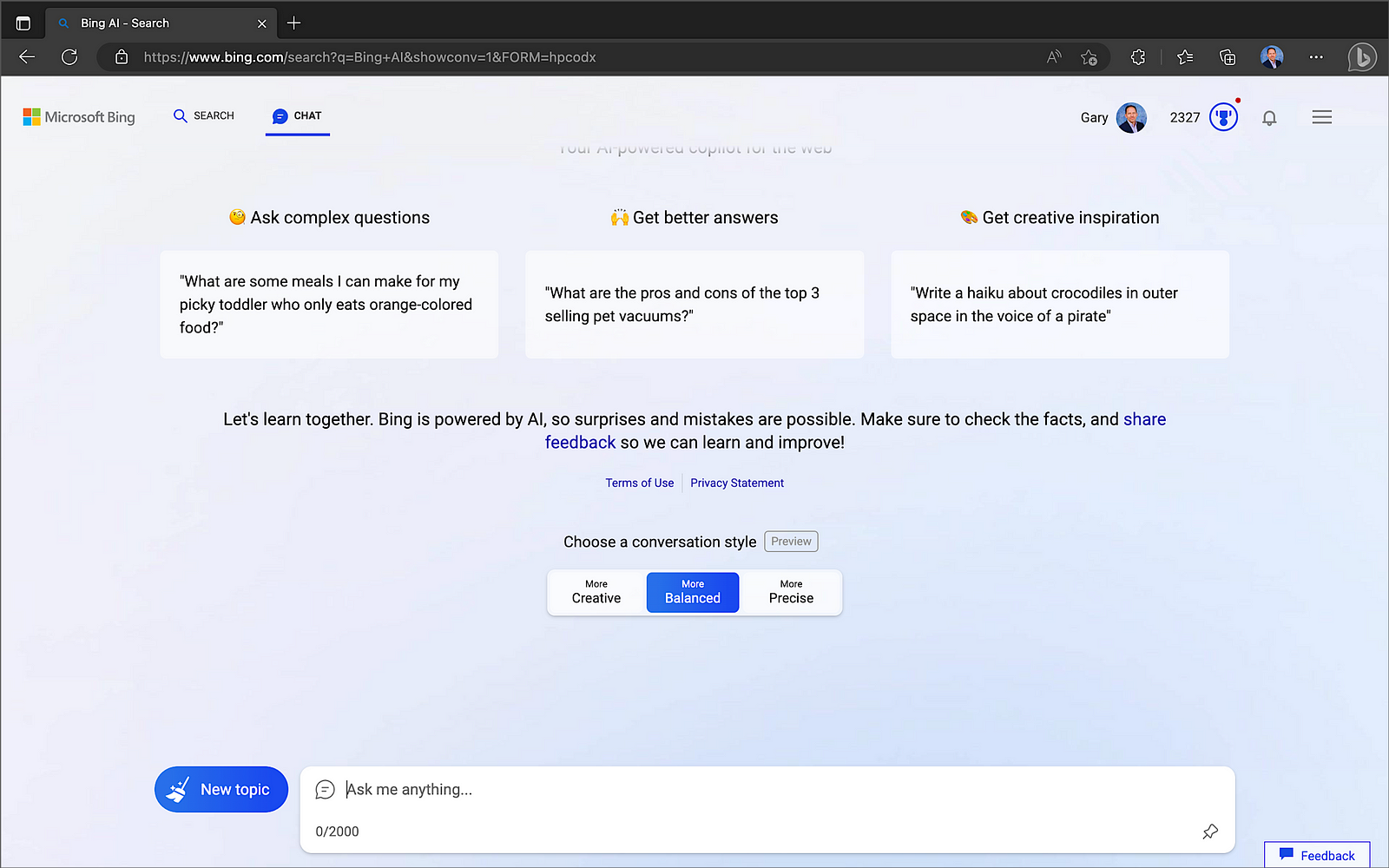
According to their blog post on February 7, Microsoft launched “an all new, AI-powered Bing search engine and Edge browser, available in preview now at Bing.com, to deliver better search, more complete answers, a new chat experience and the ability to generate content. We think of these tools as an AI copilot for the web.” The latest version of Bing “is running on a new, next-generation OpenAI large language model that is more powerful than ChatGPT and customized specifically for search. It takes key learnings and advancements from ChatGPT and GPT-3.5 — and it is even faster, more accurate and more capable.” On March 14, Microsoft confirmed the new Bing runs on OpenAI’s latest GPT-4.
Getting Started with Bing Chat
Bing’s Chat mode is only available when you access Bing using Microsoft Edge.

Microsoft Edge is available for most major platforms, including MacOS, iOS, and Android.

Using Bing Chat
Bing Chat now supports up to 15 chats per session and 150 per day. Users can supply up to 15 prompts (questions or instructions) to create and improve the code results. When responding, Bing considers the context of previous prompts in the same chat session.

Bing Chat Results
Like OpenAI ChatGPT, Bing Chat delivered accurate, error-free, and well-written code. Although ChatGPT and Bing Chat are not IDE-based tools, the resulting code is easily copied into your project or saved to disk. Additionally, these tools provide an excellent opportunity to learn new languages and coding techniques without requiring an IDE.

ChatSonic

ChatSonic is a service of Writesonic. According to Y Combinator, startup Writesonic, founded by Samanyou Garg, is backed by leading venture capital firms, including Y Combinator, HOF Capital, Rebel Fund, Soma Capital, Broom Ventures, Amino Capital, and some of the best angels from different industries.
ChatSonic claims to improve upon the limitations of ChatGPT. According to Wordsonic, ChatSonic is “a powerful chatbot, powered by Google Search, allowing it to provide up-to-date and accurate content and hence superior to ChatGPT, which can not generate content on topics after September 2021. Additionally, it can create digital images and respond to voice commands and many more additional features. So, ChatSonic has addressed all the limitations of ChatGPT.”
Using ChatSonic
You can get started with ChatSonic for free, with up to 10,000 words. However, like OpenAI ChatGPT, if you want to take advantage of GPT-4, you will want to upgrade to a paid plan, starting at $13/month with an annual commitment.

Using ChatSonic is nearly identical to using OpenAI ChatGPT.

During my testing for this article, I ran into several issues with ChatSonic’s Premium Plan’s Free Trial. For example, the code block constantly flashed and refreshed on the screen using Chrome for Mac; a minor issue but highly annoying. Also, when copying or downloading code results, you get both code and the informational text, which you must separate. Worse, the final code block did not always include all the code output; the code was intermixed with informational text. Lastly, when using follow-up instructions to modify the results, the regenerated code often missed previous code modifications. In my tests, after several follow-up instructions, the resulting code was missing up to one-third of the previous statements. Due to these issues, the resulting code block was malformed and unrunnable. The more I chatted with ChatSonic, the worse the code issues became, and the issues were repeatable.


ChatSonic Results
Unlike ChatGPT and Bing Chat, ChatSonic’s Premium Plan’s Free Trial did not deliver accurate, error-free, or well-written code during my tests. Although later tests with fewer follow-up instructions provided better though incomplete results, my first impressions were unfavorable. The results might be improved using ChatSonic’s Superior or Ultimate Plans, which use the newest GPT-4 model. However, given the results of Premium, I was not keen to invest in the paid plan to find out.
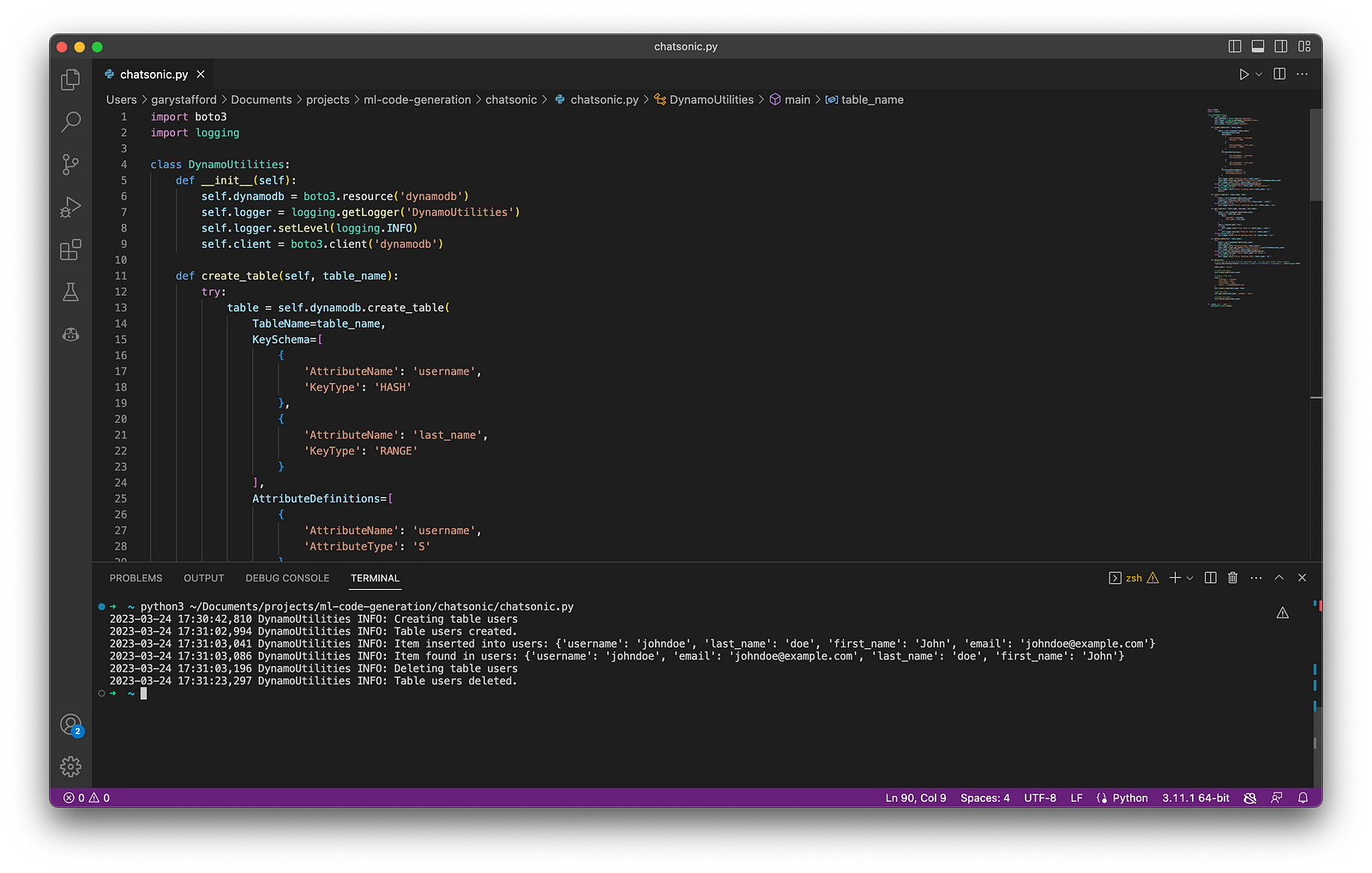
Tabnine

According to the VC-backed, Israel-based startup Tabnine, “Tabnine is to create and deliver a top-to-bottom AI-assisted development workflow that empowers all code creators, in all languages, from concept through to completion.” Tabnine Pro serves whole-line, full-function, and natural language to code completions. Regarding AI, in Tabline’s opinion, “a multi-model approach far outperforms a monolithic approach. That’s why we’ve developed language-specific code native AI models, which are pre-trained on code and provide faster and more accurate code completions based on your tech stack.” To learn more about their models, read Tabnine’s blog post, Tabnine Enterprise vs. ChatGPT Plus.
Getting Started with Tabline
You can get started with Tabline for free with the Starter plan. However, the features of the Starter plan are limited compared to the Pro Plan, which starts at $12/month for a single user.

You can try out the Pro plan’s features, which are free for 14 days.

Tabnine supports a wide range of programming languages.
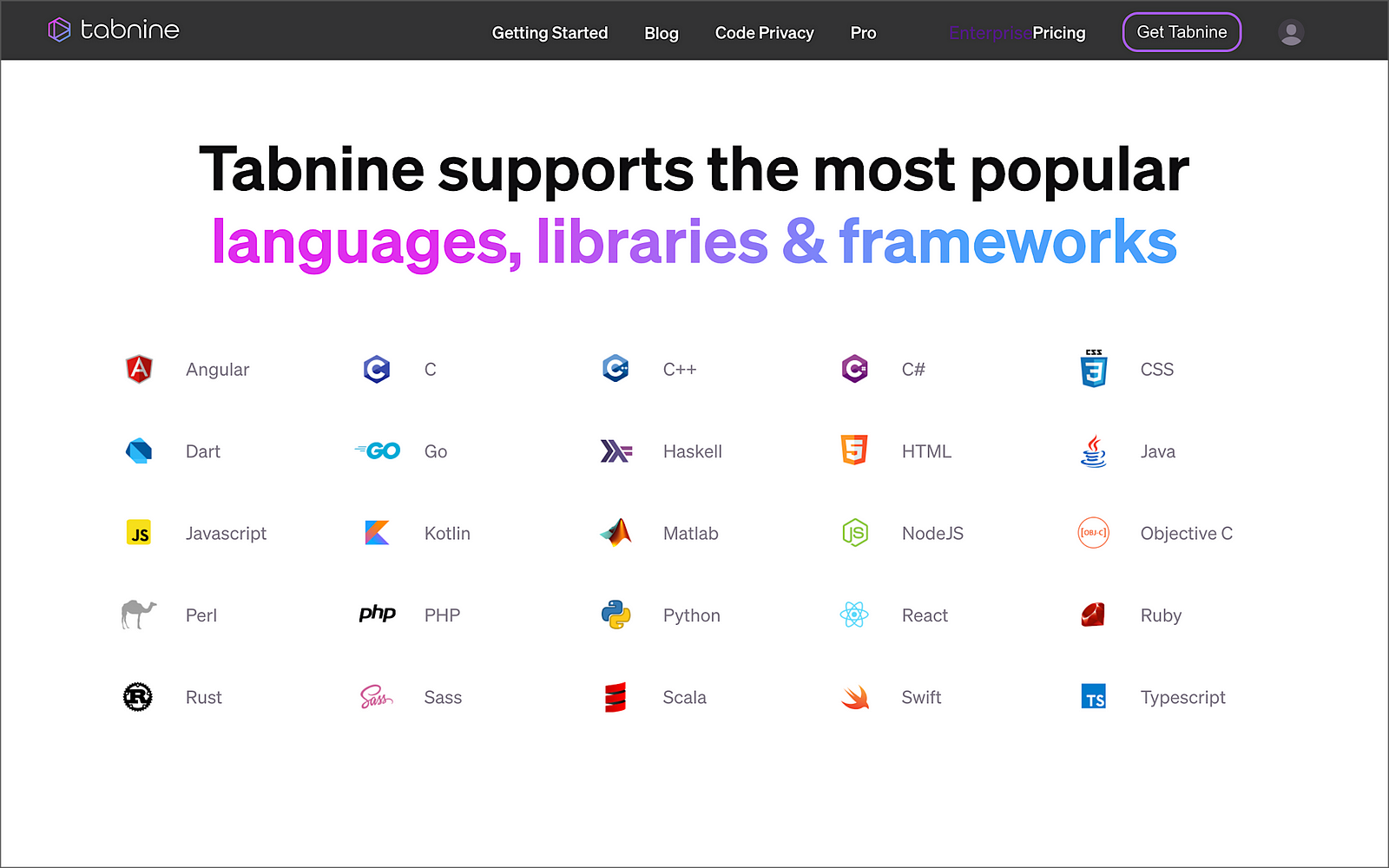
To get started with Tabline, choose your favorite IDE and install the required extensions or plugins.

Tabnine provides automated or manual IDE installation.

The Tabnine extension for VS Code already has a staggering 5.1 million downloads! A valuable tip learned from testing the IDE-based tools was to disable all non-essential extensions to give me a baseline of the tool’s capabilities. Initially, with over eighty VS Code extensions enabled, I found it hard to separate and understand each tool’s features and potential conflicts with other extensions I had loaded, especially other generative AI tools.

Using Tabnine
As discussed earlier, Tabnine, like GitHub Copilot and Amazon CodeWhisperer, uses generative AI technology to predict and suggest subsequent lines of code based on context and syntax within your IDE. It is like having IntelliSense on steroids.
Like Copilot and CodeWhisperer, it takes some practice to get efficient with Tabnine. After starting with the initial import and logging statements, I used code comments to generate the functions, then returned to add exception-catching and logging.
Tabnine, like Copilot and CodeWhisperer, includes a collapsible navigation bar. However, unlike those tools, I found Tabnine’s navigation bar provided little value, in my opinion. It seemed more like marketing stats and a way to encourage more users to sign-up rather than providing useful development features like Copilot and CodeWhisperer.
Below, we see an example of Tabnine Pro’s ability to generate whole-line code completion (line 11) and full-function code completion (lines 12–41) based on the existing code context and syntax (lines 1–11).

Tabnine Results
Given my development knowledge and experience with similar tools, I found the final code results with Tabnine Pro were accurate, error-free, and well-formed (Pythonic). However, I would have liked to see additional features to differentiate Tabnine from its competitors.

GitHub Copilot

According to GitHub, “Copilot is an AI pair programmer that offers autocomplete-style suggestions as you code. You can receive suggestions from GitHub Copilot either by starting to write the code you want to use or by writing a natural language comment describing what you want the code to do. In addition, GitHub Copilot analyzes the context in the file you are editing and related files, and offers suggestions from within your text editor.” Copilot is powered by OpenAI Codex, a new AI system created by OpenAI.
Given the vast popularity and volume of code on GitHub, it is no wonder Copilot is trained in all languages that appear in GitHub’s public repositories. GitHub points out that the quality of suggestions you receive may depend on the volume and diversity of training data for that language.
GitHub Copilot X
GitHub is extending Copilot’s capabilities, with the announcement of GitHub Copolit X on March 21, 2023. According to GitHub, “With chat and terminal interfaces, support for pull requests, and early adoption of OpenAI’s GPT-4, GitHub Copilot X is our vision for the future of AI-powered software development. Integrated into every part of your workflow.”
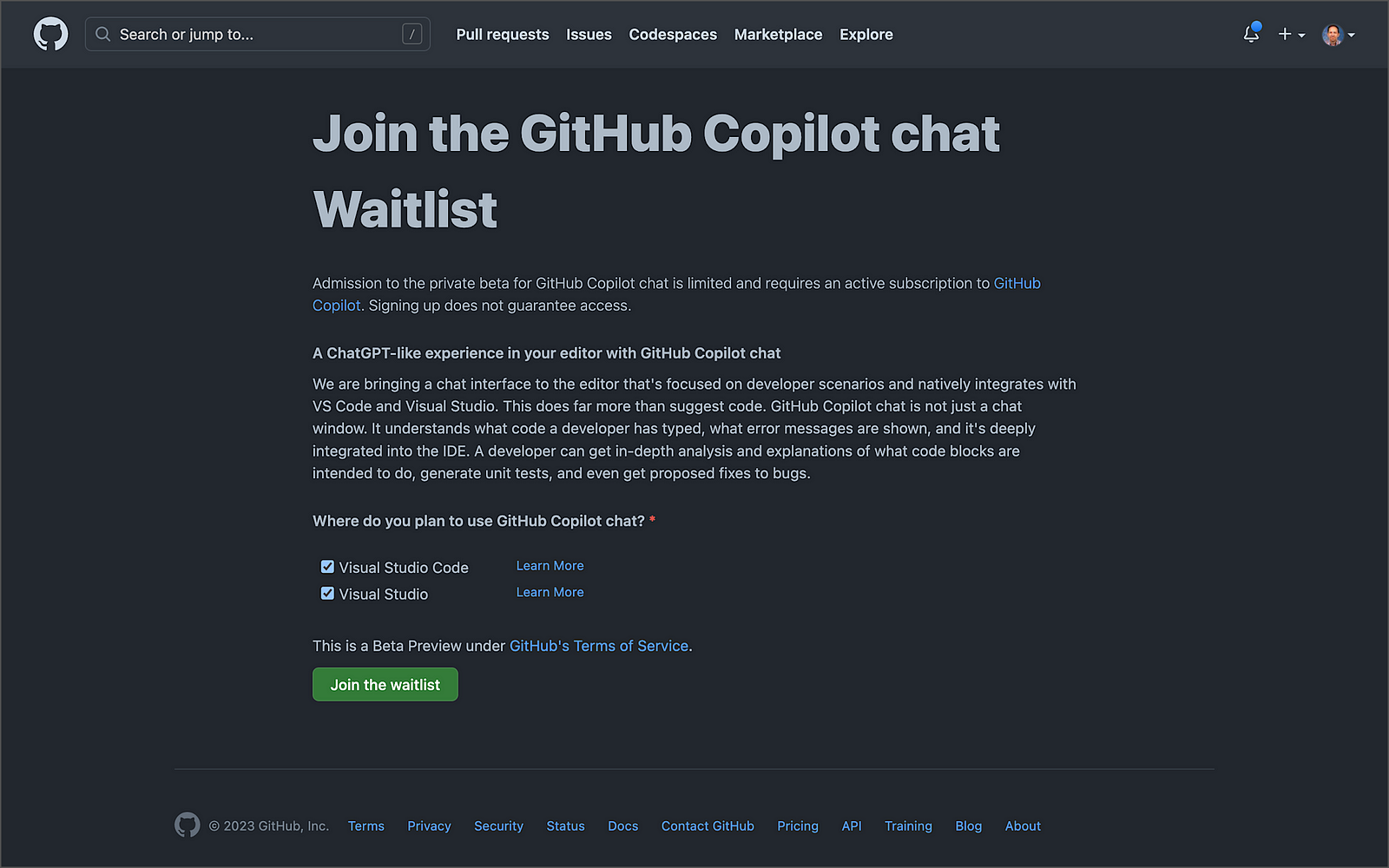
Getting Started with Copilot
Get started with GitHub Copilot for as little as $10/month. This Monthly Plan is a great way to test Copilot’s capabilities. In addition, GitHub is currently offering a 60-day free trial of Copilot.

Regarding IDE support, Copilot is currently available as an extension in Visual Studio Code, Visual Studio, Neovim, and the JetBrains suite of IDEs. The GitHub Copilot extension already has 4.2 million downloads, and the GitHub Copilot Nightly extension, used for this post, has almost 250,000 downloads.

GitHub Copilot can also be used with Codespaces, GitHub’s fully configured development environments in the Cloud based on VS Code, similar to AWS Cloud9.
Using Copilot
As discussed earlier, GitHub Copilot, like Tabnine and Amazon CodeWhisperer, uses generative AI technology to predict and suggest new lines of code based on existing context and syntax. In addition, Copilot includes an inline pop-up toolbar, which makes it easier to scroll through and accept code choices.
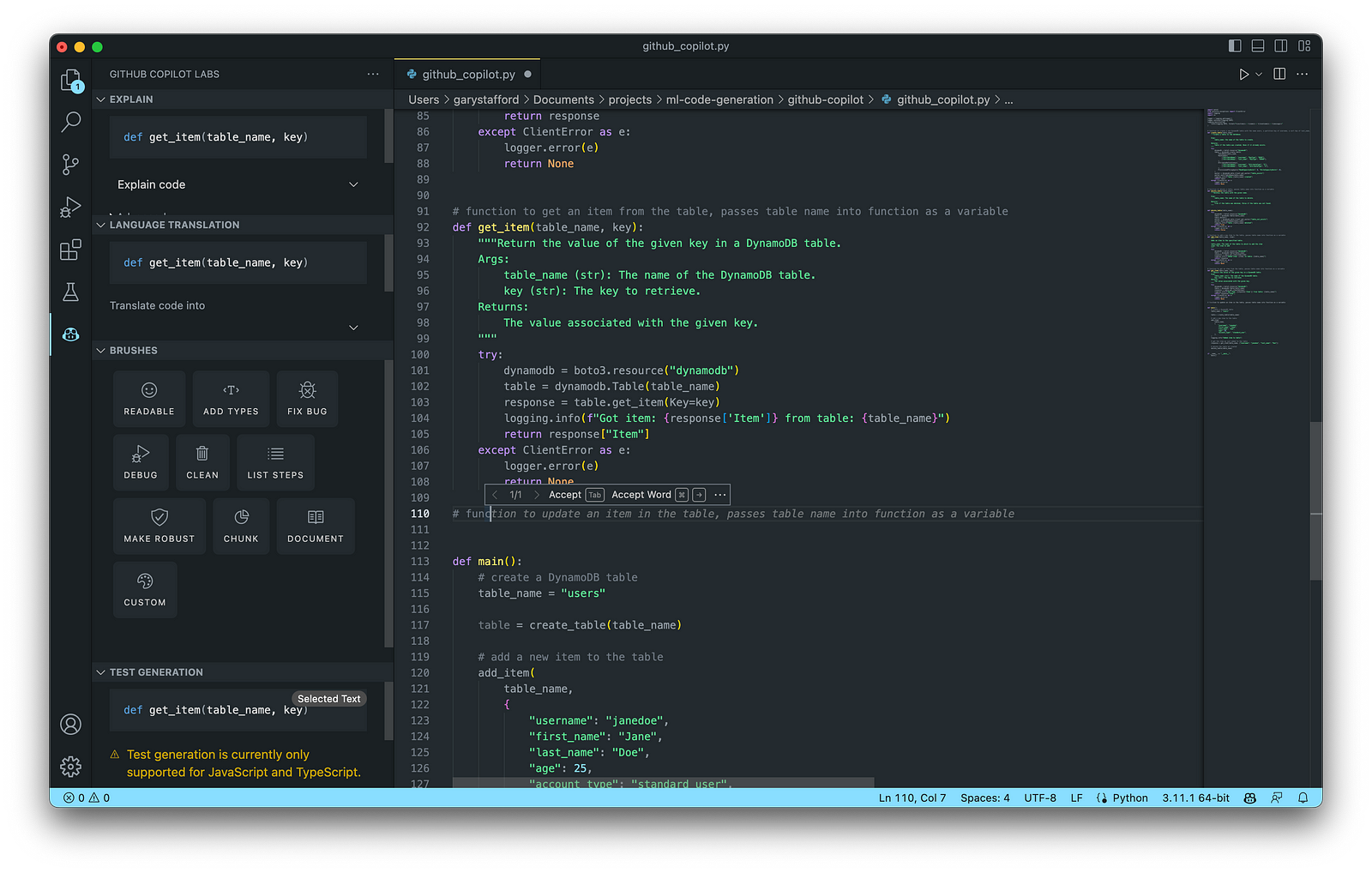
Copilot also has an extensive collapsible navigation bar, which can explain the code, offer language translations, provide access to Copilot’s Brushes, and can even generate tests. My only disappointment with Copilot is that test generation is currently only supported for JavaScript and TypeScript, given Python’s enormous popularity.

Below, we see an example of Copilot’s ability to generate whole-line code completion (line 14) and full-function code completion (lines 15–34) based on the existing code context and syntax (lines 1–14).

Copilot Results
Given my development knowledge and experience with similar tools, the final code results with Copilot were accurate, error-free, and well-formed. I found Copilot’s additional features, especially those found on its collapsible navigation bar, extended its functionality well beyond most similar generative AI tools I tested. Lastly, I felt Copilot’s ability to learn from the existing code context and syntax was superior to other tools.
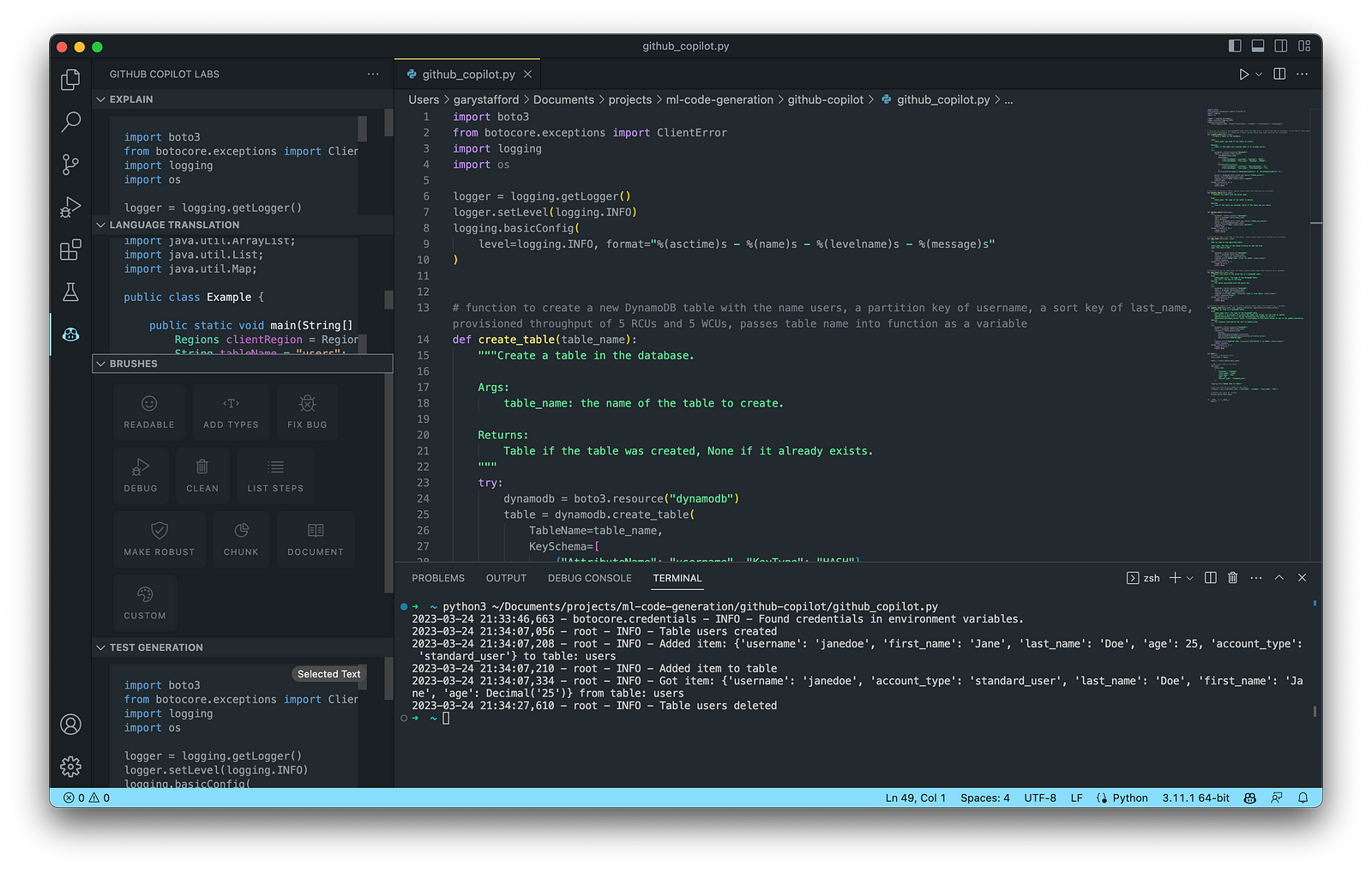
Amazon CodeWhisperer (Preview)

According to AWS, Amazon CodeWhisperer, announced in June 2022, “is a general purpose, machine learning-powered code generator that provides you with code recommendations, in real time. As you write code, CodeWhisperer automatically generates suggestions based on your existing code and comments. Your personalized recommendations can vary in size and scope, ranging from a single line comment to fully formed functions.” CodeWhisperer code generation is powered by ML models trained on various data sources, including Amazon and open-source code.
CodeWhisperer currently supports Java, JavaScript, Python, C#, and TypeScript. Although these are some of the most popular languages, CodeWhisperer’s language support is limited compared to Tabnine and Copilot.
Getting Started with CodeWhisperer
It is easy to get started with CodeWhisperer. Unfortunately, final pricing is unavailable since Amazon CodeWhisperer is still in Preview as of late March 2023.

CodeWhisperer enhances your IDE using AWS Toolkit for JetBrains, AWS Toolkit for Visual Studio Code, AWS Lambda console, and AWS Cloud9. With Lambda and AWS Cloud9, the setup simply involves activating CodeWhisperer within the IDE.

Getting started with CodeWhisperer requires installing the AWS Toolkit if applicable, choosing your authentication method, and setting up your Builder ID, IAM Identity Center (AWS SSO), or IAM.

AWS Builder ID
According to the documentation, “the AWS Builder ID is a new personal profile for everyone who builds on AWS. Your AWS Builder ID provides access to tools and builder services on AWS, including Amazon CodeCatalyst and Amazon CodeWhisperer. You can keep your AWS Builder ID as you move between jobs, schools, or other organizations. AWS Builder IDs are free. You only pay for the AWS resources you consume in your AWS accounts.”

Using CodeWhisperer
Nearly identical to Copilot and Tabnine, Amazon CodeWhisperer provides real-time code recommendations in your IDE. Unique features of CodeWhisperer include first-class support for AWS APIs, built-in security scans, a code reference tracker, and responsible AI/ML, which avoids bias by filtering out code recommendations that might be considered biased and unfair.
Below, we see an example of CodeWhisperer’s ability to generate whole-line code completion (line 14) and full-function code completion (lines 15–27) based on the existing code context and syntax (lines 1–14).

CodeWhisperer Results
Like my feedback on Tabnine and Copilot, the final code results with CodeWhisperer were accurate, error-free, and well-formed. In addition, I appreciated the added benefits of CodeWhisperer’s Security Scan and Reference Tracker to identify significant code from other projects.

Other Options
There are many other tools in the Generative AI coding category of comparable quality to the six featured in this post. New tools are being released on an almost daily basis.
Google Bard
On March 21, 2023, Google announced limited access to Bard, an early experiment that lets you collaborate with generative AI. They are beginning with the U.S. and the U.K. and will expand to more countries and languages over time. Bard is based on Google’s LaMDA (Language Model for Dialogue Applications), a transformer-based model.

Azure OpenAI Service with GPT-4
On March 21, 2023, Microsoft announced that GPT-4 was available in preview in Azure OpenAI Service. Unfortunately, Azure OpenAI Service requires registration and is currently only available to approved enterprise customers and partners. To get started, if you are qualified, you must trudge through the 25-question form.

Replit Ghostwriter
California-based VC-backed startup Replit has put the power of Replit’s AI into the world’s most popular online IDE. Replit “automates away the repetitive parts of coding, so you can stay focused on making your creative vision a reality.” Replit announced Ghostwriter Chat, which allows you to chat with a coding AI directly in your IDE. It now has a proactive debugger and awareness of your project’s code.
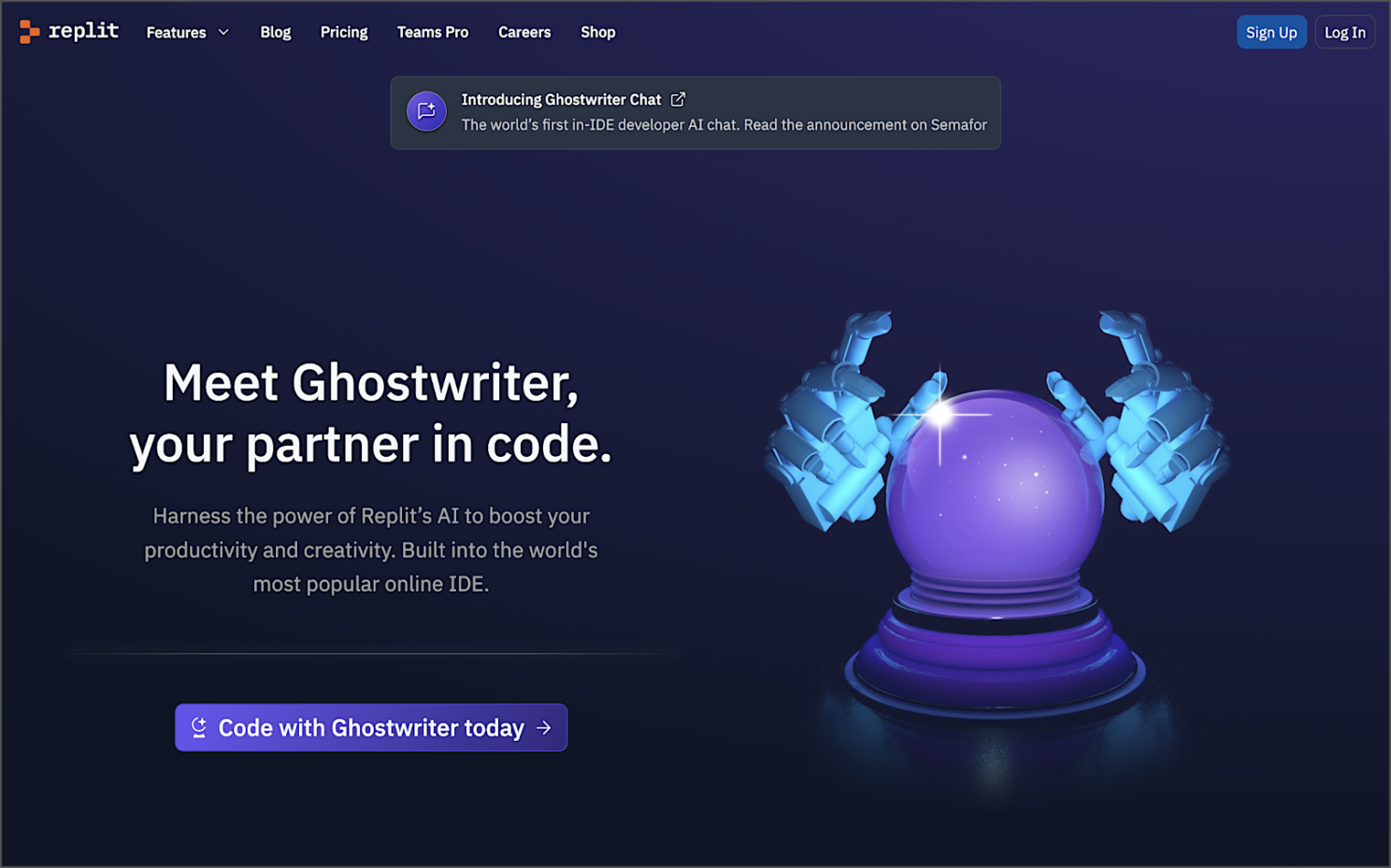
Conclusion
In this post, we examined six popular generative AI-powered coding tools, including chat-based OpenAI ChatGPT, Microsoft’s all-new Bing Chat, and ChatSonic, as well as IDE-based GitHub Copilot, Amazon CodeWhisperer (Preview), and Tabnine. Each tool assisted with developing an identical program to complete everyday database tasks on AWS. We then compared and contrasted the ease of use and the resulting code accuracy and quality of the tools. The generative AI space is moving at a breakneck pace. Tools continue to rapidly improve their AI models, add new features, and adjust pricing.
Recommended References
- Article: Top Artificial Intelligence (AI) Tools That Can Generate Code To Help Programmers (Marktechpost)
- Article: Top 29 ChatGPT alternatives that will blow your mind in 2023 (Free & Paid) (Writesonic)
- Research Paper: Deep Learning for Source Code Modeling and Generation: Models, Applications and Challenges (Triet H. M. Le, Hao Chen, M. Ali Babar)
- Article: NLP vs. NLU vs. NLG: the differences between three natural language processing concepts (IBM)
- Article: Top 17 Generative AI-based Programming Tools (For Developers) (Toward AI)
🔔 To keep up with future content, follow Gary Stafford on LinkedIn.
This blog represents my viewpoints and not those of my employer, Amazon Web Services (AWS). All product names, logos, and brands are the property of their respective owners.